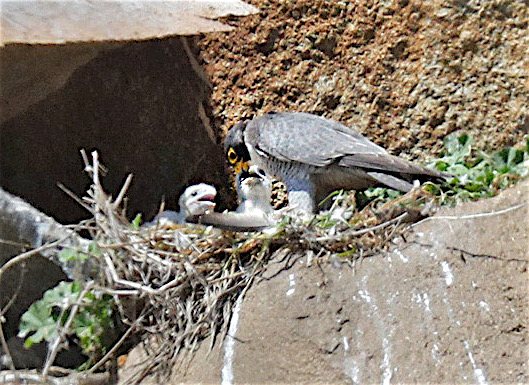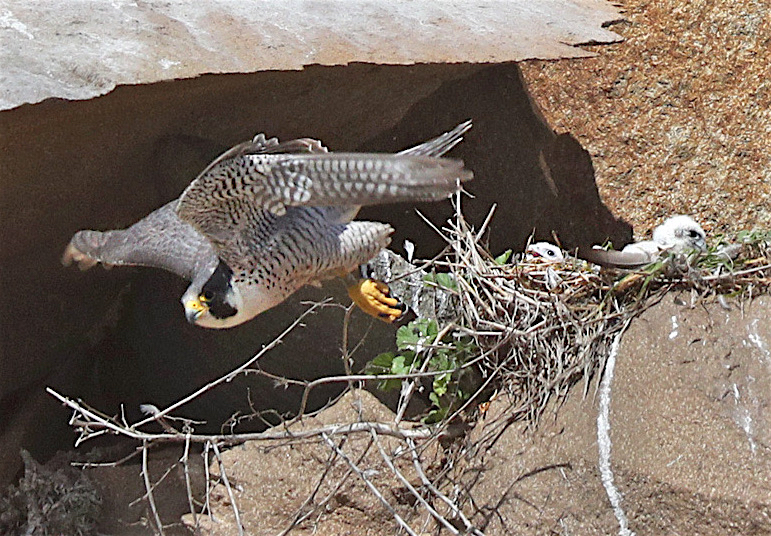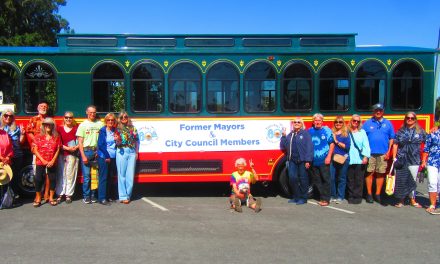Visitors to Morro Bay delight in watching the antics of the southern sea otters, who tend to gather in the waters off Target Rock and in the lee of the South T-pier, both affording terrific vantage spots to see the fascinating sea weasels.
But Morro Bay is also famous for another kind of nature watching, namely birds and, specifically, peregrine falcons. And right now is a great time to put eyes on the fastest birds in the world.
Pacific Coast Peregrine Watch (pacificcoastperegrinewatch.org) is a nonprofit group of volunteers who keep an eye on the breeding pairs of peregrine falcons that annually nest in the caves of the sheer cliffs of Morro Rock.
The Watchers, led by Bob Isenberg, stand vigil on a daily basis (weather permitting), watching the protected falcons as they build nests, hatch chicks, and feed the hungry little mouths with birds snatched right out of the air.
“The birds are beginning to nest now,” reads an April 3 post by Isenberg on the Watchers’ website. “Both pairs north and south have begun selecting nest sites in the last two weeks. Normal progression for this time of year is egg laying in the middle of April. Hatching will be 31 to 33 days later. Forty-four days to fledging from day of hatching. In other words by the first of June, you should see young falcons flying.”
Isenberg and the Watchers set up spotting scopes in the parking lot by Target Rock, or around the ocean side of Morro Rock at the end of Coleman Drive to watch the nests on either side of the monolith.

Isenberg has been watching the falcons for a very long time but is getting off to a late start this nesting season. Isenberg said he recently underwent back surgery and has been rehabilitating at the Bayside Care Facility in Morro Bay. He said he should be back on his feet again and back on falcon watch around May 1.
Meanwhile, another volunteer watcher has taken up the post.
“Not to fear the Peregrine Falcons are in good hands with Bob’s buddy, Jerry Pyle,” reads the post, “who is providing the spotting scopes and information.”
So if you’re down by Target Rock and see a white van with some gentlemen peering into telescopes trained on the Rock, stop by and say hello.
They will point out the peregrine nests, which are almost impossible to detect with the naked eye, as the nests are hundreds of feet up the Rock. But once Isenberg and the Watchers point them out to you, you’ll be able to find them yourself. Cameras with telephoto lenses are needed to take photos of the birds.
Peregrines have a large range where they are found, literally across the planet. But the birds were nearly wiped out in the 1950s to ’70s by pesticides, in particular DDT, which made their eggs brittle and prevented them from hatching.
They were listed on the endangered species list in the 1970s, but now that DDT is banned, they’ve made a remarkable comeback. Morro Rock was named a sanctuary for the peregrines in 1972 and the public prohibited from climbing the Rock to protect the birds, though getting to one of the nests would take serious rock climbing gear.
In the 1990s a conservation group from UC Santa Cruz came out annually to remove the eggs from the falcon nest (there was just one pair back then), repelling down the rock face to remove the fertile eggs and replace them with placebos. The eggs were then hatched in a lab and the baby falcons returned to the nest where the parents reared and fledged them.
It was an annual ritual that went on for about a decade and saw pretty good success. They also ran a banding program to track the birds.
Over the past 25-30 years, the peregrines’ numbers increased enough to remove them from the ESA; however, they are still protected through the Predatory Bird Act and Morro Rock is still off limits to climbers. Groups like the Watchers also protect the birds.
Another significant action that was taken by State Parks was to remove the colonies of feral cats that once roamed the Rock and presented an invasive species and formidable predator to all the wildlife on Morro Rock.







